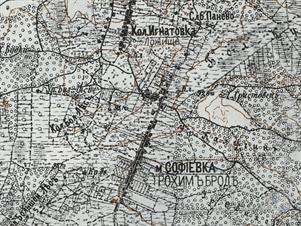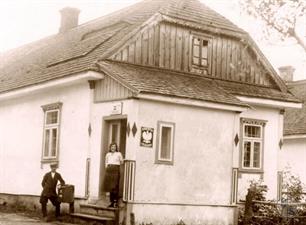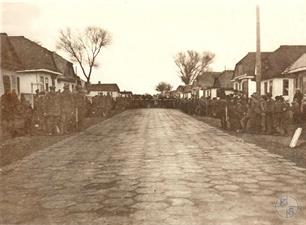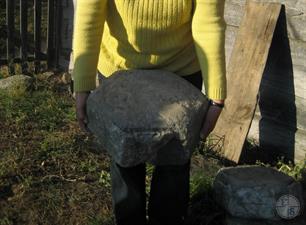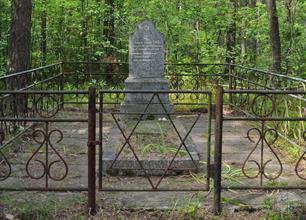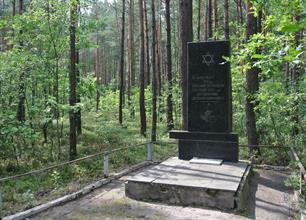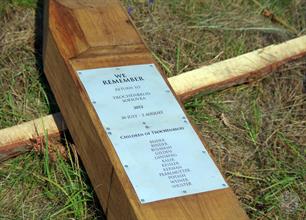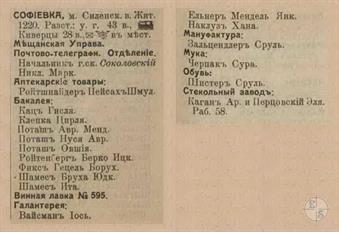Trochimbrod (Sofievka)
Of the three and a half thousand Jews, Trochimbrod survived, according to various sources, 30-40 people. These were those who had false documents, who were hidden by Ukrainian and Polish families, or who managed to escape from the ghetto.
Almost three dozen Jews of Trochimbrod and of also destroyed town of Lozhche, led by Grigory Rosenblat, created a partisan group.
In the 1970s, monuments were erected at the site of the executions of Jews. In 1990 they were updated.
Trochimbard gained fame thanks to the novel by Jonathan Safran Foyer “All illuminated”, according to which the movie of the same name was shot in 2005.
In 2011, researcher Avrom Bendavid-Val published the book “Empty Heaven: Opening the Lost City Trochimbrod”. Later, on the basis of the book, the documentary "Lost City" was shot.
After the release of the film “All illuminated” in 2006, the history of Sofievka-Trochimbrod and Hnativka-Lozhysche attracted public attention. In 2012, the descendants of immigrants from Sofievka and Hnativka living in Israel arranged a large expedition to destroyed town. The expedition was headed by the grandson of the natives of Hnativka Haya Firer, a former Israeli Air Force Commander, Major General Avihu Ben Nun.
Almost three dozen Jews of Trochimbrod and of also destroyed town of Lozhche, led by Grigory Rosenblat, created a partisan group.
In the 1970s, monuments were erected at the site of the executions of Jews. In 1990 they were updated.
Trochimbard gained fame thanks to the novel by Jonathan Safran Foyer “All illuminated”, according to which the movie of the same name was shot in 2005.
In 2011, researcher Avrom Bendavid-Val published the book “Empty Heaven: Opening the Lost City Trochimbrod”. Later, on the basis of the book, the documentary "Lost City" was shot.
After the release of the film “All illuminated” in 2006, the history of Sofievka-Trochimbrod and Hnativka-Lozhysche attracted public attention. In 2012, the descendants of immigrants from Sofievka and Hnativka living in Israel arranged a large expedition to destroyed town. The expedition was headed by the grandson of the natives of Hnativka Haya Firer, a former Israeli Air Force Commander, Major General Avihu Ben Nun.
In July 1941, German soldiers with the help of schutsmans gathered 150 local men, they took them to the Kivertsy station on trucks and shot them in the yard of the prison. A ghetto was created in the center of Trochimbrod, where Jews were brought from the neighboring Jewish town of Lozhysche (Ignatovka) and the surrounding villages.
On August 9, 1942, the mass extermination of the Jewish population of Trochimbrod began. On that Saturday morning, 20 German soldiers from Ainzantz group and 100 shutsmans entered 11 trucks in the ghetto. The Jews were ordered to come to the ghetto center, put all the jewelry, and then 100 people on trucks were thrown in the Yaromel Forest, where the pit were already dug. The last execution occurred on September 21, in Yom Kipur.
Two dozen Jews left, processing the lether for the Germans. They were transferred to the largest synagogue in the northern part of the town. In December 1942, when the reserves of raw materials ended, the Germans also shot them. The synagogue was burned.
Residents of the surrounding villages and farms forced to disassemble residential buildings and other premises for building materials. The looted property was exported to the Kivertsy station, to Tsuman for sending to Germany; even a street paving stones were dismantled. The town forever ceased to exist.
On August 9, 1942, the mass extermination of the Jewish population of Trochimbrod began. On that Saturday morning, 20 German soldiers from Ainzantz group and 100 shutsmans entered 11 trucks in the ghetto. The Jews were ordered to come to the ghetto center, put all the jewelry, and then 100 people on trucks were thrown in the Yaromel Forest, where the pit were already dug. The last execution occurred on September 21, in Yom Kipur.
Two dozen Jews left, processing the lether for the Germans. They were transferred to the largest synagogue in the northern part of the town. In December 1942, when the reserves of raw materials ended, the Germans also shot them. The synagogue was burned.
Residents of the surrounding villages and farms forced to disassemble residential buildings and other premises for building materials. The looted property was exported to the Kivertsy station, to Tsuman for sending to Germany; even a street paving stones were dismantled. The town forever ceased to exist.
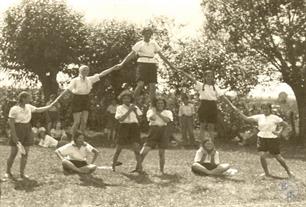 |
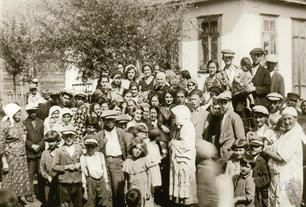 |
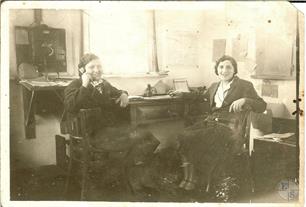 |
| Girls in the Zionist Summer Camp in Trochimbrod | Jews of Trochimbrod, 1930 | Polish post office employees in Trochimbrod |
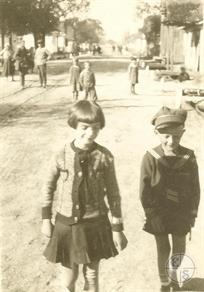 |
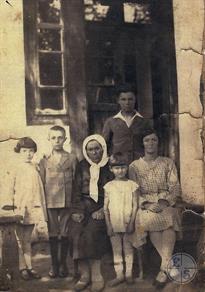 |
| Trochimbrod street. In the foreground Betty Gold and Richard Lyubinski | Idel Antvarg, her mother Beyla and children Shmuel, Rivka, Shlomo. Trochimbrod, 1925 |
For about thirty yeas, until the present war the rebbe in Trochinbrod was Rabbi Boruch-Zeev Beigel. He lived a simple life and was sharp-witted, but the residents of Trochinbrod did not like or respect him. The town had another rebbe, Rabbi Moshe Bider from Berezna. The Zionists respected him and called him the Berezner Rebbe.
At the time of World War I Rabbi Bider won some recognition from the Austrian commandant of the town. With his influence many of the Jews were forced to work on tie Sabbath and holidays were released, and their work was lessened on weekdays. During the time of Austrian rule he taught the children and young people and took care of them.
During the typhus epidemic that began in 1917, many were killed. Among them was Rabbi Bider, but his memory remained in the hearts of the people of Trochinbrod.
After his death, the two sides compromised and together placed Rabbi Gershon Weissmann in the rabbinical. office. He was the son of: Rabbi Hayim Weissmann, who was once a judge in the town and also the father-in- law of Rabbi Zeev Beigel.
Rabbi Gershon Weissmann was a unique personality. He prayed according to the custom of the Karlin Hasidim. In 1940, when the Russians captured the town, the Communists did not want this fanatical rabbi in their town. They accused him of underground salt trading and exiled him to Siberia.
Various enterprises operated in the town: an oilboy and 2 mills, an oil factory, a crests factory, a glass factory.
In 1939, the only Trochimbrod Street was paved with a hexagonal paving stones; the end of the work was marked by a solemn cut of the tape.
In 1940, together with all over Western Ukraine, the town moved to the Soviet Union (according to the Molotov -Ribbentrop Pact). The rabbi Hershon Weisman was arrested and exiled to Siberia after the Soviet authorities accused him of participating in the underground trade in salt.
At the time of World War I Rabbi Bider won some recognition from the Austrian commandant of the town. With his influence many of the Jews were forced to work on tie Sabbath and holidays were released, and their work was lessened on weekdays. During the time of Austrian rule he taught the children and young people and took care of them.
During the typhus epidemic that began in 1917, many were killed. Among them was Rabbi Bider, but his memory remained in the hearts of the people of Trochinbrod.
After his death, the two sides compromised and together placed Rabbi Gershon Weissmann in the rabbinical. office. He was the son of: Rabbi Hayim Weissmann, who was once a judge in the town and also the father-in- law of Rabbi Zeev Beigel.
Rabbi Gershon Weissmann was a unique personality. He prayed according to the custom of the Karlin Hasidim. In 1940, when the Russians captured the town, the Communists did not want this fanatical rabbi in their town. They accused him of underground salt trading and exiled him to Siberia.
Various enterprises operated in the town: an oilboy and 2 mills, an oil factory, a crests factory, a glass factory.
In 1939, the only Trochimbrod Street was paved with a hexagonal paving stones; the end of the work was marked by a solemn cut of the tape.
In 1940, together with all over Western Ukraine, the town moved to the Soviet Union (according to the Molotov -Ribbentrop Pact). The rabbi Hershon Weisman was arrested and exiled to Siberia after the Soviet authorities accused him of participating in the underground trade in salt.
Lutsk district, Volyn region
Agricultural colonies of the Volyn province
Volynia region - list of settlements and location of objects
Trochimbrod (Sofievka), 2022
Volynia region - list of settlements and location of objects
Trochimbrod (Sofievka), 2022
Sources:
- Jewish encyclopedia of Brockhaus & Efron;
- Russian Jewish encyclopedia;
- Eleazar Barco. Trochinbrod
Photo:
- Facebook Trochenbrod
- Humus. Села и местечки Волынской губернии в 1915-1918 гг. Часть 3
- Jewish encyclopedia of Brockhaus & Efron;
- Russian Jewish encyclopedia;
- Eleazar Barco. Trochinbrod
Photo:
- Facebook Trochenbrod
- Humus. Села и местечки Волынской губернии в 1915-1918 гг. Часть 3
Trochimbod was founded in 1835 as the Jewish agricultural colony of the Lutsk district of the Volyn province. It is also known as Sofievka or Zofieuka (Polish: Zofiуwka), in honor of the Russian Princess Sophia, who allegedly allowed to create the Jewish settlement in this place. The name Trochimbrod, or Trochinbrod in Yiddish stands for "Dry Bread" or "Bread without Butter" (German: Trockenbrot). Sofievka was an official name of thr township.
Soon the colony grew up in the township.
In 1889, 1,200 Jews lived in Trochimbrod (235 families),
in 1897 - 1580,
in 1938 - approx. 3000 Jews.
To the Polish period (since 1921, according to the Riga Treaty between Poland and the RSFSR), exclusively Jews lived in Trochimbrod. In order to light a stove on Shabat, a non -Jews from another town specially came. His salary was usually a piece of challah.
The mail carrier in a Jewish village was usually a Jew, but the postmaster was not, according to the Russian and Polish custom.
The inhabitants of Trochinbrod were mainly farmers, dairy farmers, and tanners. They were widely known as industrious, prosperous people. The children studies at the heder and later in yeshiva.
Soon the colony grew up in the township.
In 1889, 1,200 Jews lived in Trochimbrod (235 families),
in 1897 - 1580,
in 1938 - approx. 3000 Jews.
To the Polish period (since 1921, according to the Riga Treaty between Poland and the RSFSR), exclusively Jews lived in Trochimbrod. In order to light a stove on Shabat, a non -Jews from another town specially came. His salary was usually a piece of challah.
The mail carrier in a Jewish village was usually a Jew, but the postmaster was not, according to the Russian and Polish custom.
The inhabitants of Trochinbrod were mainly farmers, dairy farmers, and tanners. They were widely known as industrious, prosperous people. The children studies at the heder and later in yeshiva.
The area of Trochinbrod was only 640 desyatin (1,728 acres). Because it was impossible to develop and enlarge Trochinbrod many were compelled to emigrate to lands across the sea, such as North and South America, including Argentina. There, they continued to be farmers and were very prosperous.
During the World War (WW I - 1914-1918) Trochinbrod suffered much. The front was about seven kilometers from the town. Its inhabitants were forced to do jobs that they were not familiar with for the Austrian and German armies for a period of nine months. The army would distribute small portions of bread, salt, and the hindquarters of beef, which was slaughtered by Jewish butchers who worked for the army.
At the start of the Russian Revolution, the young people of Trochinbrod organized many Hebrew institutions and raised funds, but their work was disturbed when the Bolsheviks seized power. For a few months Trochinbrod was a "no-mans land" between two opposing camps - the Poles on one side and the Bolsheviks on the other. From time to time they would come to Trochinbrod and create trouble.
Merchandise came to Trochinbrod from the towns of Kowel, Lutzk and Roziszca, which already belonged to the Polish. The merchandise was sold for gold coins to the inhabitants of the town or to merchants from Rowne.
Many robbers used to hide in the woods, waiting for merchants. They would kill the merchants and take their merchandise. So many merchants were killed in this way that a special place was made for them in the town's cemetery.
When Trochinbrod was captured by the Polish, the national Zionist organization resumed its former order, and the people of Trochinbrod worked with renewed zest. They raised more money and taught Hebrew in a Hebrew school, headed by Rabbi Eliyahu David Yisroel Schuster, who also gave private Hebrew lessons. Teaching and learning Hebrew was one of the main functions of the Zionist organization.
At the of the fourth aliyah some Jews from Trochinbrod came to Israel, and later many others tried to do so as well. There were many difficulties, and only seven of them actually made it to Israel. No one knows what became of the many that could not get there.
There were 7 synagogues in Trochinbrod. There were 3 big ones and 4 Hasidic study houses, named after the Hasidic leaders from Trisk, Olika, Berezna, and Styfem. But when the rebbe from Trisk visited the town, even the Hasidim from the other study houses came to hear him teach. The residents respected every "good Jew" (as they used to call the Hasidic leaders).
During the World War (WW I - 1914-1918) Trochinbrod suffered much. The front was about seven kilometers from the town. Its inhabitants were forced to do jobs that they were not familiar with for the Austrian and German armies for a period of nine months. The army would distribute small portions of bread, salt, and the hindquarters of beef, which was slaughtered by Jewish butchers who worked for the army.
At the start of the Russian Revolution, the young people of Trochinbrod organized many Hebrew institutions and raised funds, but their work was disturbed when the Bolsheviks seized power. For a few months Trochinbrod was a "no-mans land" between two opposing camps - the Poles on one side and the Bolsheviks on the other. From time to time they would come to Trochinbrod and create trouble.
Merchandise came to Trochinbrod from the towns of Kowel, Lutzk and Roziszca, which already belonged to the Polish. The merchandise was sold for gold coins to the inhabitants of the town or to merchants from Rowne.
Many robbers used to hide in the woods, waiting for merchants. They would kill the merchants and take their merchandise. So many merchants were killed in this way that a special place was made for them in the town's cemetery.
When Trochinbrod was captured by the Polish, the national Zionist organization resumed its former order, and the people of Trochinbrod worked with renewed zest. They raised more money and taught Hebrew in a Hebrew school, headed by Rabbi Eliyahu David Yisroel Schuster, who also gave private Hebrew lessons. Teaching and learning Hebrew was one of the main functions of the Zionist organization.
At the of the fourth aliyah some Jews from Trochinbrod came to Israel, and later many others tried to do so as well. There were many difficulties, and only seven of them actually made it to Israel. No one knows what became of the many that could not get there.
There were 7 synagogues in Trochinbrod. There were 3 big ones and 4 Hasidic study houses, named after the Hasidic leaders from Trisk, Olika, Berezna, and Styfem. But when the rebbe from Trisk visited the town, even the Hasidim from the other study houses came to hear him teach. The residents respected every "good Jew" (as they used to call the Hasidic leaders).

- Home
- Shtetls
- Vinnytsia region
- Volyn region
- Dnipro region
- Donetsk region
- Zhytomyr region
- Zakarpattia region
- Zaporizhzhia region
- Ivano-Frankivsk region
- Kyiv region
- Kropyvnytskyi region
- Luhansk region
- Lviv region
- Mykolayiv region
- Odessa region
- Poltava region
- Rivne region
- Sumy region
- Ternopil region
- Kharkiv region
- Kherson region
- Khmelnytskyi region
- Chernihiv region
- Chernivtsi region
- Cherkasy region
- Crimea
- Synagogues
- Cemeteries
- Objects & guides
- Old photos
- History
- Contact
Jewish towns of Ukraine
My shtetl
My shtetl
Donate
Jewish towns of Ukraine
